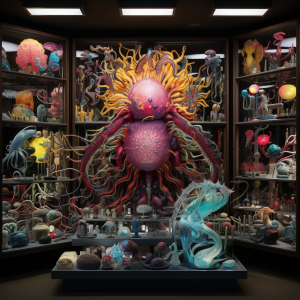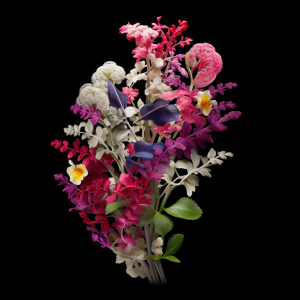Synthetic biology as a new medium for art
Thought
Merging biotechnology with artistic expression to create dynamic, living sculptures.

Note
Synthetic biology as a new medium for art.
Analysis
Synthetic biology is a field that manipulates organisms or their components to create new abilities and outputs. Recognizing it as a canvas for creative expression extends the domain of art into the living world. This challenges our conception of art as static and unchanging, allowing for art pieces that evolve, interact with their environment, and have the potential to be self-sustaining or even self-replicating. It aligns with the idea of bisociation as described by Arthur Koestler, which pertains to the intersection of two unrelated contexts—art and biology—in this case, to produce something novel.
The implications of synthetic biology as an art form are both exhilarating and ethereal. By harnessing the power of living cells, artists could create pieces that grow, change color, emit scents, or even respond to audience presence—an artistic venture with living, breathing canvases. Assumptions to consider include public acceptance, ethical boundaries, and environmental impact. What does it mean for an artwork to be alive, and how do weensure its right to life and well-being? Mental models of static art must shift to accommodate these dynamic forms, raising questions about the permanence and the transient nature of art.
In regards to sources, the field of synthetic biology is rich with research and exploration. Here are some references that give insight into the foundations and possibilities of this idea:

Books
- "Regenesis: How Synthetic Biology Will Reinvent Nature and Ourselves" by George M. Church and Ed Regis
- "Biopunk: Solving Biotech's Biggest Problems in Kitchens and Garages" by Marcus Wohlsen
- "Life at the Speed of Light: From the Double Helix to the Dawn of Digital Life" by J. Craig Venter
Papers
- "Biological Components Can Turn Invisible Objects Visible" by Peng Yin (Harvard's Wyss Institute)
- "Synthetic Biology: Applications Come of Age" by Ahmad S. Khalil & James J. Collins
Tools and Existing Products
- CRISPR-Cas9: A tool for precise genetic editing.
- Amino Labs: Kits for beginners in genetic design.
- Glowing Plant: A project that aimed to create plants that glow in the dark through genetic engineering.

Services or other Objects
- BioArt Laboratories: An innovation center that blends art and biology.
- "Victimless Leather" by the Tissue Culture & Art Project: A prototype for a piece of 'living' clothing.
With this idea comes the challenge of discussing the ethical and safety implications inherent to the manipulation of living organisms. This is not just creation but also the stewardship of life forms that, while designed, do not have the natural evolutionary safeguards. The principle of scarcity reminds us that biological resources, ethical considerations, and public understanding are all limited and need careful allocation and management, promoting the creative use of this scarcity to drive innovation.
The principle of the double loop applies here as well—new technologies in synthetic biology may draw artists and scientists to the field, fostering a creative environment that generates new biological tools and artistic concepts, forming a virtuous cycle between innovation and creation. The conjunction of biology with art may engender a new understanding and appreciation of life, pushing the boundaries of what it means to create and transform our cultural landscape.
This concept of synthetic biology as a medium for living art, once refined and ethically explored, could revolutionize how our society perceives both art and biology, potentially impacting education, ethics, and environmental design, as well as creating a whole new category of artistic expression that blurs the lines between the organic and the artistic.




